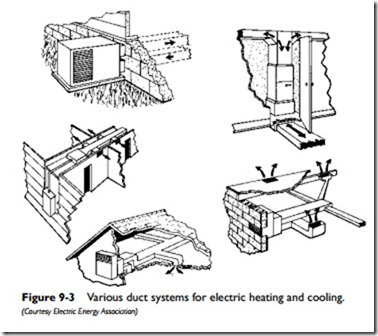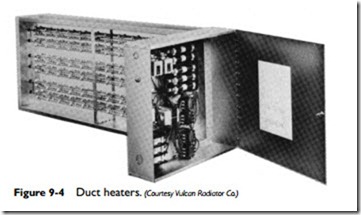Central Forced-Warm-Air Heating Systems
Central forced-warm-air heating systems that use electricity to heat or cool the air rely upon the following heat sources:
1. Electric furnaces
2. Duct heaters
3. Heat pumps
Regardless of the heat source, the air is circulated by fans through a duct system to the various rooms. Variations of these ducted air systems are shown in Figure 9-3.
The electric furnace is a complete unit designed for zero clearance and available in several models suitable for either horizontal or vertical installation. The heat is provided by fast-activating,
coiled-resistance-wire heating elements. When there is more than one coil, the individual coils are energized at intervals in sequence to prevent the type of current overload possible if all were energized simultaneously. The heating coil sequencer is activated and controlled by a low-voltage thermostat mounted on a wall in some convenient location. Overheating of the furnace is prevented by the same type of high-limit control found in other types of furnaces. The warm air is forced through the duct system to outlets in the room by a blower. Evaporator coils can be added to the furnace for cooling. Additional modifications can provide humidity control (humidification and dehumidification), ventilation, and air filtration.
A more detailed description of electric-fired furnaces is found in Chapter 14, “Electric-Fired Furnaces.” For further information on forced-warm-air heating systems, read the appropriate sections in Chapter 6, “Warm-Air Heating Systems.” Controls for this heating system are described in the section Electric Heating and Cooling Controls in this chapter and in Chapter 4 of Volume 2, “Thermostats and Humidistats.”
Duct heaters (Figure 9-4) are factory-assembled units installed in the main (primary) or branching ducts leading from the blower unit. Heat is provided by parallel rows of resistance wire formed in the shape of spirals, which may be sheathed or left open. The blower is housed in a specially constructed and insulated cabinet to which the ducts are connected. This unit functions as the power source for circulating the air through the duct heater and the rest of the system. Cooling can be provided by adding a cooling unit to the blower. Humidity control is possible by first supercooling the air in
the coil and then reheating it to the desired temperature and moisture content when it passes through the duct heater.
Some duct heaters are designed to be inserted into a portion of the duct through a hole cut in its side and are more or less permanent units. Other duct heaters are assembled at the factory in a portion of duct flanged for easy installation at the site.
Duct heaters may be installed in more than one duct to provide zoned heating. When this is the case, each duct heater is provided with means for independent temperature control. Another common method is to install a single duct heater in the main (primary) duct leading from the blower unit. Controls for either installation are similar to those used on electric-fired furnaces (see earlier para- graphs in this section).
The third type of heat source used in ducted, central forced- warm-air heating systems is the air-to-air or water-to-air heat pump. These are described briefly in another section of this chapter (see Heat Pumps), and in greater detail in Chapter 10 of Volume 3, “Heat Pumps.”

